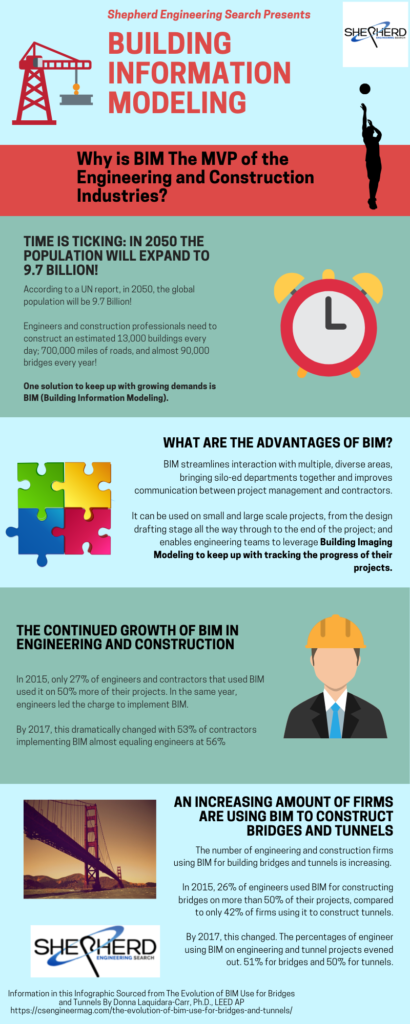Have you ever been late to a meeting? Hailed
a cab and someone jumped in before you? Or missed a bus? The sands of time wait
for nobody to catch up. Imagine trying to meet a deadline on a global scale.
According to the latest UN report, there will be 9.7 billion people living on our planet
by 2050, and two-thirds of the population will be living
in cities. You think cities are crowded now, wait until 2050. There will be repercussions if construction
firms across the globe don’t build an average of 13,000 buildings every day;
construct 700,000 miles of roads, and almost 90,000 bridges every year until
2050, which is when the alarm clock is predicted to go off!
Thankfully, there is a solution…
A viable solution is available now. We
don’t have to wait for some time in the future. Before we go into its many
applications, just what does the MVP (Most Valuable Player) of the construction
industry known as BIM (Building Imaging Modeling) do?
Thomas Coubau writing for Aproplan.com
describes BIM as the “process spanning the generation and management of the physical and functional
information of a project.” BIM also supports “decision
making throughout the project cycle”. Covers everything from the
beginning conception to demolition.
People often don’t understand and
underestimate BIM; they view it as merely a 3D modeling, while this is part of
it, there are many other aspects. BIM and similar technologies involve far more
than “3D (width, height, and depth).” They also include the dimensions of
“4D (time), 5D (cost)” advancing “…to 6D (as-built operation).”
Construction Tech Review says
cooperation between multiple teams is critical for the success of any project.
It is equally important for project teams to meet deadlines and maintain
high-quality work with the lowest possible budget.
How does BIM achieve this?
- By
integrating BIM, project managers are “able to streamline the interaction…” in
multiple areas such as “mechanical,
electrical, plumbing, data management, and material management.”
It also improves communication between
project management and contractors. The result is a project that runs with
optimal efficiency. - Numerous
organizations have applied BIM to small and large-scale projects. Engineering
and construction firms use it from the beginning drafting design all the way
through to the final project. - All
personnel involved in the project can access the master model/design. Designers
can continuously update the model with RFIs (Request for Information). - BIM
enables engineers and project management to “leverage
Building Imaging Modeling Technology” to keep updated with a project’s
progress and plans.
BIM’s use in tall buildings, roads, and
highways
One of the advantages of constructing
tall buildings is that all the floor designs are just about the same, except
for the ground floor. Horizontal construction on the other hand, such as bridges,
roads, and highways are more of a challenge. Geoff Zeiss writing for Geospatial’s
blog says it is “because
of the ground topography and existing infrastructure.”
In the past five years, there have
been exciting developments in BIM, especially
in the transportation sector.
According to a study in 2015 that focused
on the business value of BIM for infrastructure, 27% of engineers and contractors
used BIM “on
50% or more of their projects”.
In 2015, engineers led the charge to increase the implementation of BIM. By
2017, over 53% of contractors had implemented BIM and 56% of engineers.
That same study showed that BIM use
has also grown in the construction
of bridges and tunnels. In 2015, only 26% of engineering companies
were using BIM for the construction of bridges “on 50% or more of their
projects,” in comparison to 42% of engineers working on tunnel projects. By
2017, the percentages of engineers using BIM on bridge and tunnel construction
were almost even, “at 51% for bridges and 50% for tunnels.”
What is the reason for this upward
trend?
According
to Cory Dippold, VP and Head of Special Project Applications at Mott MacDonald,
the growth of BIM in the transport sector is due to advances in using BIM tools.
Today, Building
Information Modeling tools have an improved capacity to manage “massive amounts of data generated by
transportation projects.”
Dippold says BIM still has room to grow. The current version of BIM supports
the Design for Manufactured Assembly and Dippold believes that this will be a
major driver for growth in its use in bridge and tunnel projects because it
provides quicker construction methods and a higher level of quality control.

The Final Countdown: How BIM spells a
brighter future
In 2050, just 30 years from now, the
planet’s population will swell to 9.7 Billion. The consequences for the
environmental health of societies across the globe are a current topic debated
far beyond the engineering community. What is not often considered is what the
report from the UN shows, that engineers and construction professionals will
need to move fast to ensure cities and infrastructure can cope with this
population explosion. Among the exciting and pragmatic solutions is BIM. First,
on the practical level, BIM strengthens collaboration and cohesion between all
the parts of a project from those that are drafting a design to those involved
in its construction, and for client-facing project managers.
So why are we excited? Well, its
applications and use are growing every minute. The latest growth is in the
transportation engineering sector. Engineers, construction professionals, and
contractors are growing proponents of BIM. In the last five years, its
applications have been very exciting. For construction professionals and the
rest of us, the next chapter of Building Information Modeling holds great
promise and we cannot wait to see how it grows and develops.


